Buffy the Vampire Slayer: An Exploration of Sound in Storytelling
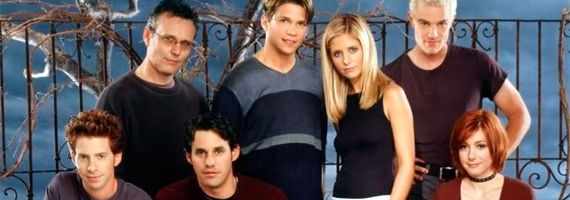
Blasphemous is the television on mute. It is an amalgam of moving pictures, of pretty faces, and flashing lights. There is little structure, minimal coherence, and the bare bones of a story. (Yes, I realize that there exists something called closed captioning, but work with me here.) In the modern era of television, sound is the key to enjoying most narratives. Gone are the days of title cards and overdramatic actresses batting their eyelashes. These days, dialogue and music run rampant on just about every channel you flip to. But are they absolutely necessary to telling a story on television? No.
So what if one were to remove or alter one of these sound elements? What would happen to the nature of the story then? Years ago, a little television series attempted this feat not once, but three times. The cult-classic Buffy the Vampire Slayer has been lauded for its pro-feminist protagonist, its compelling characters, and snappy, pop-culture-dowsed dialogue. What Buffy also succeeded in was telling a story in countlessly unique ways. The episode “The Zeppo” took place from the perspective of Xander, one of Buffy’s non-superpowered friends. The usual narrative structure from our female lead’s point-of-view was tossed aside in favor of a comedic, oft-ridiculed character and his eventual development of strength and bravery. So if the writers of the show were willing to depart from traditional storytelling structures this early on, what was in store for the rest of the series?
Ask any fan of Buffy the Vampire Slayer to list their favorite episodes and you’ll hear these names pop up frequently: “Hush,” “The Body,” and “Once More with Feeling.” These episodes all depart from conventional TV storytelling methods, but they also share a common factor: the unique employment of sound elements. “Hush” removes words and tells a story through music. “The Body” removes music to tell the story with only words. “Once More with Feeling” integrates words into music and vice-versa. Together, these three episodes form their own sort of trilogy, highlighting the importance of the presence (and absence) of sound can have on the television story.
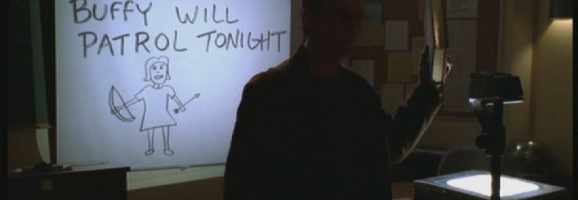
The conception of “Hush” was creator Joss Whedon’s response to certain critics of Buffy. These critics claimed that the show’s only saving grace was its witty dialogue, a factor which could only carry the plot for so long. Whedon wrote up a script in which demons known as The Gentlemen invade Buffy’s town and steal the inhabitants’ voices. Chaos immediately ensues as classes are cancelled, voice-recognition software ceases to work, and innocents are unable to scream for help when attacked. The story progresses when the main characters learn to communicate in creative ways, from miming to tapping to writing on whiteboards. Nonverbal signals become essential to the unfolding of the plot. We see the initial chemistry between Willow, a witch, and newcomer Tara when they wordlessly create a barrier against The Gentlemen. Rupert Giles’ role towards Buffy as a father figure immediately becomes clear when she silently hugs him for support. Meanwhile, background music serves to relay the absurdity of the situation and heighten tension.
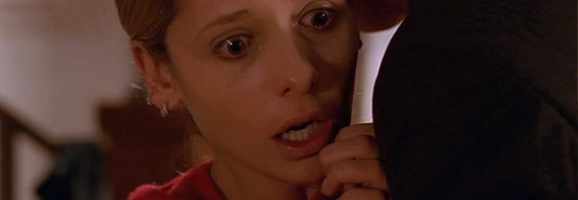
Next we move onto “The Body,” a difficult episode to view because of its stark realism, heightened by the lack of music throughout. The story unfolds when Buffy comes home to find her mother Joyce’s lifeless body on the couch. Joyce has died, not from supernatural causes, but because of a sudden brain aneurysm. The sudden news hits viewers as well as Buffy hard, as we are treated to disorienting camera effects and nauseating editing. She approaches the body slowly, whimpering, “Mom? Mom? …Mommy?” Throughout this episode, what we see of each character’s grief comes entirely from their words and dialogue. One of the most powerful scenes comes from a monologue by Anya, an ex-demon attempting to understand the human world. Having been overwhelmed by the anguish of her friends around her, she cries out, “I don’t understand how this all happens, how we go through this, I mean I knew her and then she’s, there’s just a body, I don’t understand why she just can’t get back in it and not be dead, it’s stupid, it’s mortal and stupid, Xander’s crying and not talking and I was having fruit punch and I thought that Joyce would never have any more fruit punch and she’d never have eggs, or yawn, or brush her hair, not ever and no one will explain…” The group is speechless. As in real life, there is no soundtrack, no melodramatic acoustic guitar playing in the background. There is no swelling overture, just a mutual understanding that tragedy has occurred.
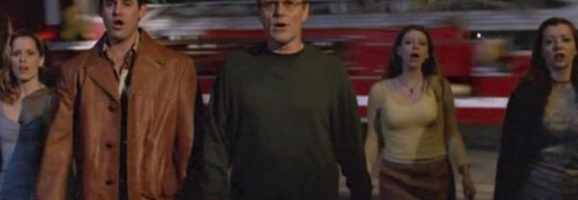
“Once More with Feeling,” one of the most popular episodes of Buffy, marks a shift from “The Body” by having music emerge full force. The plot around this episode revolves around a demon named Sweet, who forces the townspeople to confess their secrets through musical numbers. Here dialogue between characters is scarce. Instead, songs reveal the inner turmoil of each character through uninterrupted musical confessions. Newly engaged couple Anya and Xander share their anxieties about married life and gripe over each other’s flaws in their number “I’ll Never Tell.” Meanwhile, in “Going through the Motions,” Buffy sings “I always feel the strangest strangement/ Nothing here is real, nothing here is right,” revealing her apathy towards being the constant hero. By the end of this “trilogy,” music and words work in conjunction to tell the story.
Sound is an integral part of any television production. Even in the most basic TV stories, dialogue advances the plot while music creates atmosphere. As Buffy the Vampire Slayer demonstrates, however, stories can still easily be enjoyed when the basic rules of sound are broken or defied. Through compelling plots and strong character work, one can transcend even basic storytelling conventions.
What do you think? Leave a comment.

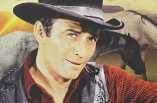








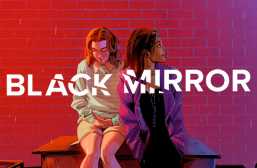
One of the things that made the show what it was was it’s ambition and being unafraid to experiment. Hush and the Body are perfect examples like that in that here’s a show about a girl who kills Vampires and yet that same show gave us maybe one of the most realistic depictions of death ever put on TV.
Buffy and Angel were my winter projects this year. Watching all 12 seasons in the span of 3 months was probably the most obsessed I’ve ever been about a TV show. Season 3 of Buffy and 5 of Angel were probably my favourites, although The Body remains one of the best episodes of a television show I’ve seen a long, long time.
For me, “The Body” is probably the best episode as well. It resonated with me in a really strong way when I first watched it. A close friend had passed away just days before I watched the episode and Buffy’s brief fantasy of saving her mother in the opening scene eerily paralleled a dream I just had. On top of that personal connection, the episode is just fantastically well done (the lack of score as detailed in this article, the small tender moments like when Tara kisses Willow, Gellar’s performance) By the end of the episode I was in tears . . . to this day it always makes me cry.
“The Body” is the one that can still make me cry. One of the finest hours television has ever produced.
The Body is definitely one of the most honest, brutal depictions of death I’ve ever seen on TV, and it would probably translate well enough to people who’ve never seen Buffy.
Great read.
Season 6 is my favorite of Buffy. Not the most popular choice, I know, but when I watched it for the first time I was going through a rough patch and to see those beloved characters facing depression, addiction, isolation and rising above it, gave me the courage to face my own problems.
And yeah the Body is probably the most important episode of television ever done.
I think “Hush” is extremely rewarding for longtime fans — you know the characters so well by that point that you can hear them in your head and know exactly what they’re thinking and doing even though they don’t speak. That takes four years of excellent writing and acting to pull off.
Hush’s daringness, genre-mixing, and humor are representative of the show’s best elements. The fact that it is a uniquely perfect example of these elements is in its favor. I don’t consider Hush to be a break with Buffy’s format. I consider it to be a showcase for Buffy’s format.
Yep, not to mention the big plot point that the entire episode is thematically centered around is that Buffy and Riley learn who each other are.
I loved that episode, and it is even more significant to me now that I know it was Whedon’s way of flipping the bird to critics who thought the show relied too heavily on the “Buffy-speak” liberally peppering the script.
Something about your opening poignant hyperbole struck a chord with me and got me thinking: sound design has really come into its own over the past two decades. Just take a look at an PTA film and you’ll know what I mean. And yet, I always find myself questioning what happened to good graphic design. You mention that a tv on mute is blasphemous. Other than perhaps Mad Men, what other shows are visually striking? Something like Breaking Bad has great cinematography, really well put together images, but would you say it’s mentionable graphic design?
I really like the movie poster for Her, but I miss the days of French New Wave design concepts, the 1970s. Television could certainly use a bolstering in the visual department.
Nice article. Very insightful.
I certainly agree that these manipulations of the conventions of sound are powerful and unique. But how reproducible are they? Could we have shows that contain a lack of sound, only containing dialogue? Perhaps we could. There are subtle noises that build tension, perhaps for something comic. Great article.
Thanks for writing this! You did a good job of tying everything together. I discovered the show over the summer and am glad to see recent writing on it 🙂 The Body is probably one of the best things I’ve ever seen on television and you picked out some of the great moments in that episode.
Love Buffy. Love your article. I can’t wait to rewatch it and really pay more attention to these episodes.
I always heard there was a musical episode of Buffy, and now I know which one it is. Thanks!
I though Hush would be hard to pay attention to, but I was surprised how interested I was!
The “trilogy” as you put it, was by far 3 of the most captivating episodes of the series. When the series came out, I was only 2 years old so I wasn’t watching it then, but when I was in elementary it was the show to watch. Buffy became this hero for all girls, showing you can be strong, and still have romance in your life. I enjoyed reading your article because it reminded me of how I reacted to those episodes when I watched them.
First off, very well written article! -cue (silent?) applause-
I’m not finished watching Buffy, but I absolutely love Joss Whedon. I feel like your article goes to show just how incredible of a writer he is. Take it from me, as a young hearing impaired individual, that while sound is important, it’s not the only way to tell a story. I look forward to watching these episodes now!
“Hush” is one of my favorites and exemplifies the master storyteller Joss is. It’s both scary and funny and really embodies everything great about Buffy. I actually think “The Body” is best in its silences -at times the amount of silence becomes uncomfortable and extended but that very discomfort engrosses you fully into the experience of Buffy losing her mom. You feel all the pain in the silence. Obviously Buffy’s dialogue is great, but sometimes the quieter episodes have the larger impact.
The effect that sound design puts on show has always been interesting. Each episode analysis really brought that out. It may be unique to find episodes that are fully dialogue based. It can not be denied that all partners in the making of this show were exceptional in their craft; the writers in my opinion, were a huge part of this. But, it wasn’t just the witty dialogue (which helped, but did not lead), that showed the story. The description, locations, character developments, and solid backgrounds for each monster are story elements that can be explored with this series. More articles involving this show will surely bring me back, I am a super fan.
This is a really interesting piece. I never realized before that “The Body” didn’t have any music, the emotion in it is so extreme that it just felt natural for there to be no music and that is what makes it a great episode. It shows that there doesn’t have to be a barrage of sound in order to make a show work, it just has to make the viewers partake in its world for however long its on and Buffy does just that.
“The Body” is an perfect example of emotional storytelling through great acting and little, but well placed, dialogue.
“Hush” is amazing at how silence can be terrifying. When everyone started talking about Slenderman several years ago, I thought, didn’t Josh Whedon already do that with Buffy?
Great article. I always recommend these episodes to newcomers for this very reason, though “Once More, with Feeling” is so rooted in the events of Season 6 that its story doesn’t stand alone quite as well. May I propose we give honorable mention to Giles’s “Some Primal Evil (I’ve Got to Warn Buffy)”? That song practically outlines his entire character in under one minute. I would’ve loved to see an extended reprise of it in the musical. Keep up the good work!
I’d never thought to link these three episodes together, but your article made me see them in a whole new light. As you say, these three always come out as ‘favourites’ and it’s persuasive that this is largely because of their experimentation with ‘norms’ of sound. I’ve always thought that Willow and Tara’s love story beginning in an episode without much dialogue, where gestures accrue more meaning, makes their relationship even more poignant. Thanks for a thought-provoking article.
Looking back at these particular Buffy episodes, they definitely are good cases for how vital a component sound is and the kind of effect it can have. You’ve touched on this and expressed this very well.
I think, for me, The Body, is the greatest example of this effectiveness.
No music and minimal sounds set up a dramatic, melancholy and heart breaking parallel to the other examples. It’s almost as if its showcasing how powerless one can become in the face of something we all will have experienced, or will experience, at least once in our lives. It’s distressing to see our steel heroine so stripped of her armour. This would not be so achingly affective were sound (music and noise) were used in the episode.
Great article that has aged well! Currently rewatching Buffy for the 3rd time. I think Buffy had some of the best sound design/engineering in TV (not to be confused with the sound effects that are just whatever). Perfect balance of background noise in scenes, great use of silence. One thing I love is how the episodes end – the audio continues for a few seconds when the credits roll in.
There are only a handful of shows that I can think of that have captured my attention similar to Buffy.